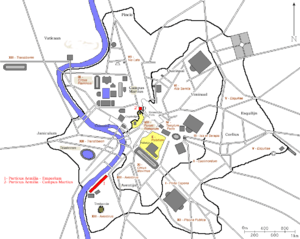Porticus Aemilia
Porticus Aemilia was a portico in ancient Rome.

History and description
The portico was built in 193 BC by aediles Marcus Aemilius Lepidus and Lucius Aemilius Paulus (from which the name associated to the gens Aemilia; Livy, 35.10.12), and was rebuilt in 174 BC by censors Quintus Fulvius Flaccus and Aulus Postumius Albinus (Livy, 41.27.8).
Sources do not mention the early function of the portico, that rose close to the Emporium, the river port of the town, arguably places near Aventine Hill. It has been suggested to identify the portico with the remains that rise between Via Beniamino Franklin and Via Marmorata: some surviving opus incertum tuff walls are still visible in Via Branca, Via Rubattino and Via Florio. In 2006 an alternative proposal identified these structures with the republican Navalia, that, in their former period, were destined to house the war ships of the Roman navy. Excavations carried out, starting from 2010, by the Soprintendenza Speciale per i Beni Archeologici di Roma in cooperation with the Reale Istituto Neerlandese di Roma and the I Municipio haven't still acquired useful informations in support of this identification,[1] but not even in support of the identification with the Porticus Aemilia quoted by literary sources (it could just be a porticoed street, between Porta Trigemina and the Emporium, and not a warehouse).
The opus incertum building was very large, 487 metres (1,598 ft) long, 60 metres (200 ft) large and divided into several rooms by 294 pillars, that formed seven rows depthwise and 50 naves, each covered by a series of overlapping vaults 8.30 metres (27.2 ft) large; the total covered surface was 25,000 square metres (270,000 sq ft).[2] The distance between the building and the river - where, maybe since the last Republican age, the wares uloaded from the boats were stocked - was about 90 metres (300 ft). From an architectural point of view, the utilitarian edifices were very interesting for Roman architects, as in this kind of buildings they could widely experiment the building materials trying to discover new applications.
During Trajan age or later, other edifices were interposed between the river and the opus incertum building.
Notes
- ↑ "La Porticus Aemilia regala un giardino a Testaccio". Retrieved 11.10.2013. Check date values in:
|accessdate=(help) - ↑ "Porticus Aemilia, Soprintendenza speciale per i beni archeologici di Roma". Retrieved 2012-06-30.
External links
- Ricerche in corso sui magazzini romani - Study meeting of 13–15 April 2011, Rome, National Roman Museum (in Italian only).
- Scavi in corso dal 2011 per una indagine archeologica - From the website of the Italian Society for the Protection of Cultural Heritage (in Italian only).
Bibliography
- Filippo Coarelli, Guida archeologica di Roma, Verona, Arnoldo Mondadori Editore, 1984.
- Lucos Cozza and Pier Luigi Tucci, Navalia, in Archeologia Classica 57 (2006), pp. 175–202.
- Giovanna Maria Forni, Extra Portam Trigeminam, in Atlante Tematico di Topografia Antica 22 (2012) pp. 35–40.
- Pierre Gros and Mario Torelli, Storia dell'urbanistica. Il mondo romano, Rome-Bari, Laterza, 2007.
- Giovanni Battista Piranesi, Le antichità Romane, T. 4, tav. Tav. XLVIII
- Pier Luigi Tucci, La controversa storia della Porticus Aemilia, in Archeologia Classica 63 (2012), pp. 575–591.